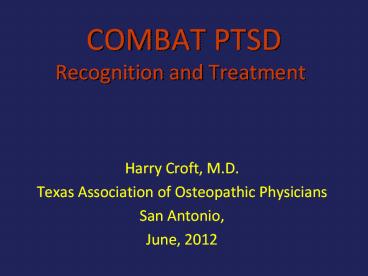COMBAT PTSD Recognition and Treatment - PowerPoint PPT Presentation
1 / 26
Title:
COMBAT PTSD Recognition and Treatment
Description:
Research and Speaking Honoraria Astra Zeneca Boehringer-Ingelheim BMS Eli Lilly Forest Pharmaceuticals GSK Otsuka Pfizer Takeda * Learning Objectives 1. – PowerPoint PPT presentation
Number of Views:169
Avg rating:3.0/5.0
Title: COMBAT PTSD Recognition and Treatment
1
COMBAT PTSDRecognition and Treatment
- Harry Croft, M.D.
- Texas Association of Osteopathic Physicians
- San Antonio,
- June, 2012
2
Research and Speaking Honoraria
Astra Zeneca Boehringer-Ingelheim BMS Eli
Lilly Forest Pharmaceuticals GSK Otsuka Pfizer Tak
eda
3
Learning Objectives
- 1. Learn usual presenting symptoms to civilian
pcp of combat related PTSD. - 2. Understand the importance of treating combat
related ptsd in addition to relieving obvious
presenting symptoms. - 3. Become familiar with common misconceptions as
well as facts regarding ptsd. - 4. Know current evidence based treatments for
ptsd.
3
4
(No Transcript)
5
WWW.MYBACKTOTHEWALL.COM
- RECOGNIZING When PTSD is in Your Life
- EDUCATING Yourself About PTSD
- CONNECTING Biology With Your Psychology
- ORGANIZING a Comprehensive Care Plan
- VIEWING Your Issues in a New Light
- EMPOWERING Yourself Through Strong Systems of
Support - REDEFINING the Meaning of Your lIfe Post
- Traumatic Growth
- T
5
6
Why Civilian Physicians Should Care
- PTSD in general population
- Returning Veterans
- 20 of 5 million
- Vietnam
- Middle East
- But what about the VA?
- Dont THEY take care of vets
- Not eligible
- No desire to go
7
Recognition of PTSDProblems for Patients and
Families
- Failure to Recognize Symptoms for what they Are
- Incorrectly Ascribe Cause
- Myths and Misconception About PTSD
- Stigma Surrounding PTSD
8
Myths and Misconceptions about PTSD
- 1. Only a soldiers problem
- 2. Only a mans problem (men acting badly)
- 3. A Psychiatric condition (denoting cowardice or
craziness or weakness - 4. Only affects those in direct combat
- 5. Almost everyone deployed to combat zone comes
back with PTSD - PTSD is an all or none disorder
9
PTSD IS.....
- Not just caused by Combat Related Trauma
- Not Just a Mans Problem
- Not Just Psychiatric Disorder
- Not all deployed to combat area
- Not all or none
- A Psycho-neuro-immunological problem
10
Recognizing PTSD Problems for Physicians -
Pr
- Patient reports only certain symptoms
- Failure to report traumatic experience/ vet
- Visit by patient not self motivated
11
Risks to Military Members More than Just Combat
- Combat
- Non-predictable Threats - to even
non-combatants - Repeated Deployments
- Repeated Separations
- Dwell time
- Unemployment / finances
12
Impacts Many Life Areas
- Relationships
- Marital, Family, Friends
- EMPLOYMENT/ EDUCATION
- Legal Problems
- Physical Health
- Risk Taking
- DESPAIR / SUICIDE
13
DIAGNOSIS
- STRESSOR
- RE-EXPERIENCING
- AVOIDANCE
- AROUSAL
- EMOTIONAL DISTRESS OR LIFE INTERFERENCE
DSM IV
14
Assessment of PTSD
- PC-PTSD Primary Care PTSD Screen
- 4 items (2 or more diagnostic)
- PCL PTSD Checklist (C M)
- 19 items (0-4) cutoff gt50
15
CO-OCCURRING CONDITIONS
- DEPRESSION
- ANXIETY DISORDERS
- Generalized, Panic, Social Phobia
- SUBSTANCE ABUSE DISORDERS
- OCD VARIANTS
16
Foundations of Treatment
- Recognition of Need for Treatment
- Decision to Get Help
- Finding a Place even if..
- Trust and Rapport
- Someone who understands
- Someone who will not judge
- Someone who will not be horrified
- BUT RAPPORT ALONE IS NOT ENOUGH
17
PSYCHOTHERAPY
- COGNITIVE-BEHAVIORAL THERAPY
- Prolonged Exposure
- Cognitive Processing Therapy
- SUPPORTIVE
- EMDR
- OTHER
18
MEDICATIONS
- ANTI-ADRENERGIC
- SSRI and SNRI
- MEDS TO AID WITH SLEEP
- Other antidepressants
- ATYPICAL Antipsychotics
- ANTI-EPILEPTICS
- Avoid BENZODIAZEPINES IF POSSIBLE
19
NEW MEDICATIONS
- CRF Antagonists
- Neuropeptide Y Agonists
- Antiadrenergic Drugs
- Selective Opiod agents
- Substance P Antagonists
- D-Cycloserine
- NMDA
- Anticonvulsants
- BDNF promoters
PTSD.VA.GOV PTSD 101
20
OTHER THERAPIES
- Meditation
- Exercise
- Yoga
- Accupuncture
- Animal Therapy
- Art and Writing
21
SUPPORT SYSTEMS
- FAMILY
- FRIENDS
- OTHER VETERANS
- ORGANIZATIONS
- HELPING OTHERS
- SPIRITUALITY
22
VIEWING ISSUES IN NEW LIGHT
- Viewing TRIGGERS as Manageable Events
- Need for Speed and other Risky Behaviors
- Viewing Relationships in a New Light
- Intimacy
- Children
23
REDEFINING LIFE AFTER PTSDPOST PTSD GROWTH
- Recognizing how others survive
- Who you are vs. what you do..or did
- Importance of lifelong growth and learning
24
Co-occurring Disorders
- Treat both disorders
- Assumption that dealing with one cures the
other is not valid - Need for support in sobriety
- One day at a time
- Medications
25
Suicide Risk Factors
- Person sees no way out and fears things will get
worse - Predominant emotions are hopelessness and
helplessness - Person is anxious, agitated and has insomnia
- Thinking is constricted with a tendency to
persieve situation as all bad - Judgement is impaired by use of alcohol or other
substances - Lack of future orientation
- Weapons are easily accessible
26
FOR MORE INFORMATION
- www.va.ptsd.gov
- www.medscape.com
- www.ptsd.va.gov/professional/pages/assessments/ncp
tsd-instrument-request-form.asp - TO DOWNLOAD PCL-M AND PCP PCL
- www.mybacktothewall.com































